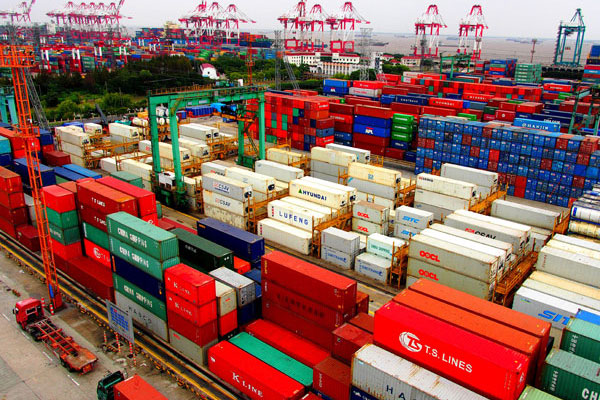Containers pile up at Waigaoqiao Port in the Shanghai Free Trade Zone. [Photo/Xinhua]
But challenges remain as commodity prices keep dropping, demand stays weak

Declines in China's foreign trade will ease after the first quarter, but conditions will remain severe and complex this year, the Ministry of Commerce predicted on Thursday.
Weak trading activities in the first two months of the year were affected by the Spring Festival holiday, which had disrupted the trade performance, ministry spokesman Shen Danyang said.
Saying that the decline will ease after March, Shen added, "China's trade conditions this year will remain complex, compared with 2015, as international commodity prices keep falling and demand for goods in both developed and developing economies remains weak."
China's exports in dollar-denominated terms were more than 25 percent lower year-on-year in February.
This was a worsening of the 11.2 percent decline in January and the sharpest drop since May 2009, according to the General Administration of Customs.
But Shen said, "We are prudently optimistic about foreign trade this year.
"We are confident of keeping the same growth rate in foreign trade this year as last, based on growth mode transformation and restructuring."
China recorded a 7 percent drop in foreign trade last year. It did not set an exact growth target for foreign trade in this year's Government Work Report.
Shen said the decline in the nation's export growth rate was far lower than that of other major economies including the United States, Canada, Japan, Brazil and India during the first two months of this year.
Eager to attract more foreign investment to put the country's economic growth on a firmer footing, Shen said the ministry will introduce six measures this year.
These will include further loosening the requirement for foreign investment in service sectors such as education, finance and culture, and optimizing the administrative system to enhance work efficiency.
More foreign companies will be encouraged to invest in central and western regions, and support will be given for the development of border and cross-border economic cooperation zones.
In the first two months of this year, nonfinancial foreign direct investment to China grew by 2.7 percent year-on-year to 142 billion yuan ($22.52 billion). Investment in the service sector surged by 62.8 percent of total inflow during the period, reaching 89 billion yuan.
Denis Depoux, deputy president of Roland Berger Strategy Consultants for Asia, said China's growth will be less capital intensive and investment-driven.
This also means that public decision-makers will be increasingly evaluating economic, environmental and operational efficiency, and upgrading manufacturing facilities toward more automated, digitally controlled and responsive factories, Depoux said.
Foreign direct investment in the high-tech service industry increased by 157 percent year-on-year to 16 billion yuan in the first two months of this year.
"Overall, the modernization of the Chinese industrial base will gradually improve the ability of foreign companies to market high-value-added products and services in China while creating new competition," Depoux said.
